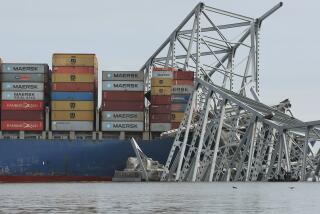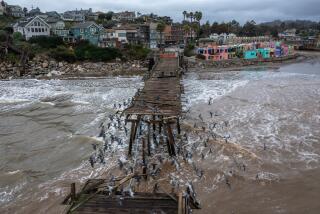BARRIER AGAINST THE SEA
- Share via
THE HAGUE — People here know better than anyone else that the sea does not give up easily.
That fact was pummeled into their national conscience in 1953 when raging storm waters swept across their tiny country, killing nearly 2,000 people, many of whom died of exposure and exhaustion after waiting on rooftops for several nights for rescue crews that got there too late.
In the aftermath of that storm, the people of Holland pledged to protect themselves at any cost so that their small country would never again suffer the consequences of 1953, no matter how fierce the North Sea becomes.
Today they are completing a massive storm control system, including a two-mile-long movable barrier that can close off an entire sea, an impressive engineering feat that makes the leaky dikes of California’s Sacramento Delta look like something built out of spare parts.
The barrier, which adds the finishing touch to a system that includes more than 500 miles of dikes, can be raised or lowered to interrupt mountainous storm waves from the notoriously rough North Sea on which Holland borders.
During the project, the Dutch had to build four ships, at a cost of $103 million, to do chores no one had ever done before. They reshaped the ocean bottom and built three islands across the mouth of the Oosterschelde, a sea on the southwestern coast of Holland. And they hung 62 sliding steel gates, each 130 feet long, between towers as tall as 11-story buildings so they could shut off the raging tides that sweep out of the North Sea, one of the most turbulent seas in the world.
It cost more than $4 billion, a staggering sum for such a small country, but the engineers who built it say they have at long last made peace with an old enemy.
“The sea,” mused Klaas A. Delfsma, an engineer who has been with the project for nearly two decades, “is our enemy and our friend.”
Historically, the sea supplied the livelihood--and even yielded the land on which most of modern Holland sits--and the massive storm surge protector will not end that benevolent relationship. The Dutch went to great lengths to be sure that the barrier could be opened most of the time, allowing the sea life of the Oosterschelde to flourish, and closed when the waters grew too threatening.
A new computerized system, which is now being completed, would automatically close the barrier whenever the waves in the North Sea get more than about 11 feet tall.
The need to control the sea is a common fact of life for Holland, and the Dutch have lived with that fact for centuries.
“Without dikes,” Delfsma said, “65% of Holland would be inundated.”
When the great storm of 1953 swept out of the north, it wiped out 67 bridges and dikes, according to Bruno V. Voskuil of the ministry of transport and public works.
“It was a cold, icy storm,” he said. The water raged across Holland so fiercely that “it took trees right out of the ground,” he said.
About 70,000 people lost their homes. About 10,000 cattle were lost, and damage ran into the billions.
At first, Dutch leaders thought they could solve their problem by simply closing off the Oosterschelde with a massive permanent dike. But fishermen who depend on the Oosterschelde for their living, and environmentalists who did not want to see the area changed so dramatically, fought for some sort of solution that would protect the area, yet keep the sea open.
It was, as it turned out, a staggering challenge.
“We had to invent complicated new techniques,” Voskuil said, recalling the mid-1960s when the project was conceived.
Giant concrete towers had to be erected across the mouth of the sea, and they weighed at least 18,000 tons each.
“The biggest crane in Holland at that time could lift only 500 tons,” Delfsma said. “And the biggest crane in the world was a 2,000-ton crane in Japan.”
The Dutch solved the problem by building a giant, U-shaped ship that could carry each tower to its appointed spot. That ship is now on the scrap heap because no one else, anywhere in the world, needs such a mammoth vessel.
Several other single-purpose vessels had to be built specifically for the barrier, known as the Delta Project.
To work, the 65 towers had to be erected across the mouth of the sea so precisely that they would vary no more than an inch or so from their assigned position. Otherwise, the massive steel gates that must be moved up and down would jam. That demand for exact positioning led to the construction of another ship, called the Macoma, that could guide the towers to the right spot.
But since the floor of the sea is uneven and subject to shifting, the sea floor itself had to be rebuilt.
So the Macoma was equipped with a huge vacuum cleaner that could suck up loose sediment from the seabed. Another ship was outfitted with four giant, vibrating needles that could be driven into the soil, causing it to compact.
The sea floor then was dredged and leveled. Engineers concluded, however, that the huge towers would not be stable enough unless they rested on a firm foundation on the bottom of the sea.
The answer, they concluded, was to cover the sea floor with mattresses.
A special factory was set up on a man-made island, and mattresses built of steel cable, wire mesh and gravel began rolling off the assembly line.
Each mattress, about the size of two football fields, was rolled onto a giant spindle on the stern of another ship that was built solely for the project. Patterned after the ships used to string telephone lines across the ocean, the mattress vessel looked a little like a boat with a giant role of toilet paper on its stern.
About 130 mattresses were laid across the floor of the entrance to the sea. An underwater robotic vehicle, which looks something like a tank, rolled along the mattresses to make sure they settled in the right place.
The foundation was reinforced with high-density rocks imported from Germany and Finland, and barriers were built on the ocean floor, extending half a mile out to sea, to keep the foundation from being undermined by surging tides.
Finally, the towers were put into place and the massive steel gates were installed. Powerful hydraulic cylinders drive the gates, moving them up to open the sea, down to close it.
It takes 75 minutes to close the entire system, but usually only some of the gates are closed, thus breaking up the wave patterns so the storm will not damage inland areas, while keeping the sea open to reduce the disruptive effects on the marine environment.
“There are 31 different strategies,” Delfsma said, thus allowing operators to match any storm with a measured response.
The barrier has been in operation for a little more than a year, and it has closed off the sea at least three times. But the real test, the massive storm that blows through here only once every few decades, is still ahead.
Engineers who have studied the project think the barrier will be up to the task.
World Dredging and Marine Construction, a U.S. trade journal, described the barrier in these words:
“In terms of magnitude it approaches the Great Wall of China. In terms of complexity and technical sophistication, it approaches a lunar space shot. It is unique, expensive, and quite unlike any other civil engineering project to be found on this planet.”
More to Read
Sign up for Essential California
The most important California stories and recommendations in your inbox every morning.
You may occasionally receive promotional content from the Los Angeles Times.













